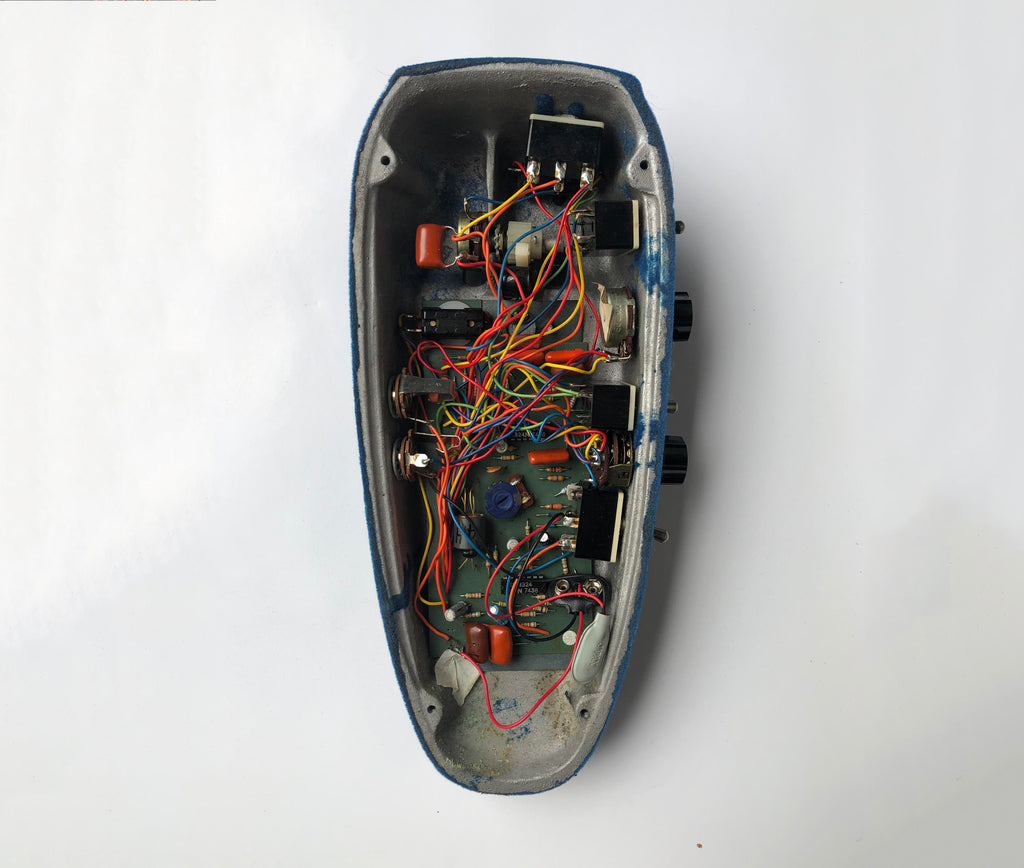Foxx Guitar Synthesizer I

Though the contents of the cabinet are filled with pedals of every sort, we have a surprising lack of vintage fuzz. There are a few, sure, and we’ll definitely get to those, but we need to talk about a fuzz pedal of a different kind first.
The year was 1971. Steve Ridinger started Foxx in Southern California when he was just 19 years old, building his first guitar pedal five years prior at the ripe old age of 14. His company went on to release one of the great fuzz pedals of all time—the Tone Machine—among several others, none of which attained the status of the Tone Machine but are great in their own rights. Each pedal was covered in a velvet-esque fabric that gave them a distinct look that stood apart from their contemporaries. On a side note, today Ridinger owns Evets Corporation, parent company to Danelectro and Snark products.
In 1972, just one short year after Foxx was founded, Mike Beigel started Musitronics, otherwise known as Mu-Tron. Began as one of the movers-and-shakers of the Guild company died in a plane crash after purchasing the rights to a synthesizer Beigel designed, Mu-Tron dissected the synth and offered up its various sections as some seriously top-notch guitar gear. His pedals carried an air of high design, featuring machined aluminum enclosures, colorful appointments and futuristic fonts.
These two roads intersected some time after the release of Mu-Tron’s “III” envelope filter pedal when Foxx released the Guitar Synthesizer I. The numbering system, the decidedly buttery filter texture and the synth reference tells you one thing: it’s more or less a copy—one of the first US-to-US clones. Nevertheless, while imitation is the sincerest form of flattery, the Foxx version went above and beyond, by offering the whole shebang in Foxx’s foot pedal configuration.
One of the biggest advancements that Beigel served up to the world of guitar electronics was the use of negative voltage to supply op-amps with gobs of headroom. While this had been implemented in synthesizers to great effect, the Mu-Tron gear was the first to offer it in pedal form and is one of several reasons why so much of the gear is so widely regarded.

Another one of Beigel’s innovations was the use of Vactrols, or optocouplers, or whatever you choose to call them. Like I explained last week regarding the Shin-Ei Uni-Vibe and the core of lamp-and-photocells, optocouplers are along the same lines, with an LED and photocell facing each other and sealed in epoxy for maximum light transmission. While I cannot say for sure that Beigel’s Phasor (the first Mu-Tron effect) was the first effect to feature an optocoupler, it definitely accounted for the Mu-Tron line’s smooth tone and flat EQ profile, all while adding gobs of warmth.
This brings us to the Foxx unit. More or less a copy of the Mu-Tron III, the GSI starts with the foundation of the III but adds on in subtle ways, namely with two different “Arpeggio” modes and the ability to assign one of the functions to the foot pedal. Even though I own the exact one, the instructions are so vague that outside of the arpeggiator modes, you’d be hard pressed to figure out what exactly Foxx is talking about without just playing it; there’s a knob labeled Strike, and everything not immediately pertaining to the envelope circuit is called an “aftereffect.” Some example settings are “Chirp” and “Pseudo-Phase.” Pure madness. Thankfully, fiddling with the controls for an extended period of time lets you know what’s happening. And what is happening sounds truly great.
The GSI also takes two nine-volt batteries to provide the same type of headroom as the III without a clunky mains cord or costly transformers. This was a boon if you were assembling a huge pedalboard and you didn’t want to also run a high-powered surge protector, but guitarists just weren’t to that point yet. And studio guys didn’t care about cutting the cord; the added cost was peanuts to most studio owners, and all Mu-Tron stuff was under lock-and-key because it sounded so great. For Foxx, It was a recipe for failure.
Needless to say, the GSI didn’t move many units but it remains an ambitious and frankly great sounding circuit from a mostly-forgotten company that produced many of them. There’s a lot to love about sheer force of will, and in that regard, the GSI is unparalleled.
